Feb 27, 2010 | Canada, coins, fun
After a busy few weeks, it was that time. It was time to put the plan into motion.
I check the flight schedules to find the plane was on time. This was good with all of the bad weather in the northeast.
I checked the flight path. The plane was to fly around the bad weather. Again, this is good because it was going to be on time.
I checked the traffic. I wanted to get to the airport on time without having to fight Washington’s infamous traffic.
Everything in place, it was time to go. I handed a treat to the dogs and off I went.
Driving to the airport went smooth except for one construction zone that was not on the list I checked on line. A quick detour allowed me to bypass the backup and coast into National Airport.
Parking was easy and close to the walkway over the road and passed the entrance for the Metro Blue and Yellow lines. Down the elevator and I found a seat near baggage claim.
After a few moments the reason I went to the airport arrived. Standing by the entrance to the baggage claim area was my mother-in-law, who flew from the frozen northeast to surprise her daughter (my wife) for her up coming birthday. We drove back and after a minor glitch in the plan—my wife was home walking the dogs and not in her office—we managed to complete the surprise!
Although my mother-in-law lives in Maine, the rest of their family is from Canada. I have not met them and have only had short conversations on the phone since I do not speak French and their English is limited, they do know I collect coins. One relative sent two different coins that my mother-in-law gave me tonight.
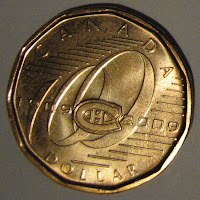 The first is a 2009 Canadian one-dollar coin. Instead of a Loony—the reverse with an image of a common loon—the reverse features a commemorative to the one hundred anniversary of the Montreal Canadiens hockey team. The standard Loonie is an eleven-sided smooth edged coin that is 26.5mm in diameter and made from bronze plated nickel. The 2009 Loonies with the Canadiens Centennial reverse was only circulated in Quebec making it a unique collectible.
The first is a 2009 Canadian one-dollar coin. Instead of a Loony—the reverse with an image of a common loon—the reverse features a commemorative to the one hundred anniversary of the Montreal Canadiens hockey team. The standard Loonie is an eleven-sided smooth edged coin that is 26.5mm in diameter and made from bronze plated nickel. The 2009 Loonies with the Canadiens Centennial reverse was only circulated in Quebec making it a unique collectible.
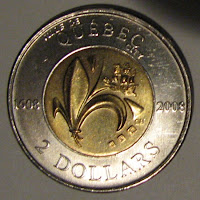 The other coin is a 2008 Canadian two-dollar coin commonly called the Toonie. The Toonie is a 28mm bimetallic coin with an outer ring made from nickel and a brass inner core. Normally, the reverse of the Toonie is a polar bear during the early summer ice flow. This Toonie commemorates the 400th Anniversary of the founding of Quebec City and the first French settlement in North America.
The other coin is a 2008 Canadian two-dollar coin commonly called the Toonie. The Toonie is a 28mm bimetallic coin with an outer ring made from nickel and a brass inner core. Normally, the reverse of the Toonie is a polar bear during the early summer ice flow. This Toonie commemorates the 400th Anniversary of the founding of Quebec City and the first French settlement in North America.
All Canadian coins feature the portrait of Queen Elizabeth II, Queen of Canada.
Surprising my wife and getting two coins for my collections made this a good day.
Jan 5, 2009 | Canada, coins, RCM
A fascinating aspect of numismatics is to learn how the coins we collect are made. Whenever a television show has a story on the production of coins or currency, I always watch with interest. One show where I have seen an interesting presentation on minting coins is on a show called How It’s Made that is airing on Discovery network’s Science Channel.
For those not familiar with How It’s Made, it shows how various items are manufactured in nicely edited five-minute vignettes. Although the producers find manufacturers all over the world to show how products are made, the show is based in Canada. So rather than try to pierce the veil of the US Mint for the show, they went to the Royal Canadian Mint to show how commemorative coins are made.
Thanks to another How It’s Made fan posting the segment on YouTube, watch how the RCM makes commemorative coins:
On January 9, 2009 at 10:30 PM (EST), the Science Channel will be airing How It’s Made: REMIX, a show where they bring in separate vignettes under one theme. This show features currency. According to their online schedule, the stories planned for this show is change machines, gold, stamps, and collectible coins. Check your local listing to find the Science Channel in your area.
Jun 2, 2008 | Britain, Canada, coins
Needing to catch up on a number of tasks this weekend, I decided to take time out and go through my pocket change. While I like to examine my change, sometimes it is not possible. So I drop the coins in a small box and promise myself to search them later. The box was overflowing making it time to search.
First, I separate quarters. Quarters are easier to examine because of their size and the fewer errors I have found. I also fill up coin tubes so that my wife has soda money for work. While searching this small box, I found two 1976 quarter with the Drummer Boy Reverse designed by Jack Ahr. It still remains one of my favorite designs.
While searching the quarters, I found a 1992 Great Britain 10 pence coin. This coin is 24.5 mm in diameter and 1.8 mm thick with a reeded edge. A US quarter dollar is 24.26 mm and 1.75 mm thick with a reeded edge. Although the design is different, the size and the silver-like color could easily have this coin mistaken for a US quarter. My only problem is that even at the current exchange rate (it takes $2 to equal £1) the coin’s value is 20-cents leaving me 5-cents short!
Within the nickels, I was able to find a well circulated 1954-S coin. It is not worth much in its current condition, but it is nice to find a coin older than me and with the mint mark on the reverse.
When searching change, there seems to always be more to find within the little brown coins that many want to complain about and eliminate. For change searching, pennies usually yield some of the more interesting finds. Aside from the number of early Memorial reverse copper cents, I was able to find 1972-S and 1974-S cents. For someone on the east coast, finding San Francisco Mint coins in change is not usual.
Of course I found a few wheat back cents. The oldest is a well circulated 1941 cent. Two others, 1956-D and 1957, are in good to very good condition with a nice, even chocolate brown toning.
We cannot forgot our neighbors to the north. With the dollar about on par with the Canadian dollar, the prospect of making a virtual profit on finding Canadian cents induces dreams of past economic times. But this time, I found two 1979 and one 2000 cents. The 1979 cents have the modified tiara portrait, a smaller portrait from previous versions, and 3.26 grams of .980 copper. It contains 2.57 (US) cents worth of metals.
The copper-plated zinc 2000 Canadian cent, contains about one (US) cent worth of zinc.
If nothing else, it gave me a couple of hours to relax.
May 18, 2008 | Canada, supplies
Whitman Publishing sent out an email notice announcing that they will be selling a complete line of folders for Canada coins. With a shipping date of May 23, Whitman’s 12 new folders will include large cents, small cents (2 folders), 25 cents (5 folders), and dollars (4 folders).
The announcement did not mention folders for the 5 cents, 10 cents, and two dollar (Toonie) coins.
When I started collecting Canadian coins a few years ago, I first went to Whitman for folders and albums. That is when I found that Whitman discontinued producing Canadian coin folders. I bought a few used folders from the secondary market, but were disappointed with their quality. After a search and then having a conversation with a Canadian coin dealer, I found Gardmaster Coin Albums.
Pockets in Gardmaster albums are in a slider that fits into sleeves within the album page. Slide the strip from the page, place the coin in the correct pocket, and slide the strip back into the page. Coins remain secured within the album. Gardmaster says the materials are archival safe.
Gardmaster albums use a snap-lock system to keep the pages secured. Although the album is not as attractive as the Whitman or other albums, the system is highly effective. If you don’t like their album, the pages will fit into almost any binder.
After having problems with the variable size of early US large cents fitting in the “standard size” Whitman folders, I bought a blank Gardmaster US Cents folder for that collection.
Although I have my favorite place to buy Gardmaster albums, others sell them in context to replace old Harco Coinmaster albums.
I highly recommend Gardmaster albums for the Canadian coin collector and others looking for a different type of album.
Jan 4, 2008 | Canada, coins, education, US Mint
If you think of the US Mint as the largest manufacturer of coins, the Royal Canadian Mint may be the largest manufacturer of non-circulating legal tender (NCLT) coins. Sure, the RCM does mint circulating coinage for Canada, but a visit to their website will introduce you to a comprehensive catalog of NCLT coins commemorating everything Canadian or international themes that affect Canada.
The RCM uses a different process than the US Mint to strike NCLT coins. The US system is more automated than the RCM uses. A friend sent a link to the following video about the minting process at the RCM from the Discovery Channel. I thought it was worth sharing. Enjoy!
Jul 23, 2007 | Canada, commemorative, history, RCM
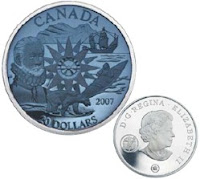 The Royal Canadian Mint is embroiled in a controversy with Inuit Tapiriit Kanatami, the Canadian organization representing four Inuit regions. This week, the RCM issued a $20 commemorative coin to mark the 125th anniversary of the establishment of research stations around the Arctic to share scientific data. It is referred to as the first international polar year. English explorer Martin Frobisher is featured on the reverse along with a 16th century ship and kayaker representing the Inuit people.
The Royal Canadian Mint is embroiled in a controversy with Inuit Tapiriit Kanatami, the Canadian organization representing four Inuit regions. This week, the RCM issued a $20 commemorative coin to mark the 125th anniversary of the establishment of research stations around the Arctic to share scientific data. It is referred to as the first international polar year. English explorer Martin Frobisher is featured on the reverse along with a 16th century ship and kayaker representing the Inuit people.
According to history, Frobisher lured an Inuit kayaker to his ship in order to bring him back to England for display. The Inuit are people indigenous of the Arctic regions of Canada and must have looked very different to the 16th century anglo-saxons from England. The captured Inuit died of disease in England.
ITK is asking the RCM to consult its organization when issuing coins about its people saying ignorance caused this mistake. The RCM is saying that they consulted experts and added the kayak as an acknowledgment of the Inuit being in the region and that it is not a commentary on those events. ITK is preparing a letter to the RCM about this coin.
Although I cannot find records of the RCM withdrawing coins, it is possible that they could cease the sale of this coin. Canada does have laws governing the fair treatment of people which could dictate what the RCM does. This is not a judgement on Canadian law. I am anticipating that if the coin does get withdraw, it will be a modern issue with a low mintage and an interesting history.
Time to go to the RCM website to order a few coins.
Image from the Royal Canadian Mint
Jul 2, 2007 | Baltimore, Canada, coins, currency, Israel, personal, registry sets, shows
When Friday rolled around, I needed a break. I needed something to take my mind off the daily grind of trying to guide the government to do right with technology. I needed coins. Lots of coins. More coins than can be experienced even when contained under one roof. I needed the Whitman Baltimore Coin and Currency Convention.
After sleeping in, I woke to kiss my wife goodbye and started to pack my backpack. Into the bag went the current editions of the Coin Dealer Newsletter, my Palm T|X that stores my inventory list, my iPod for the trip to Baltimore, and a loupe. I finished my morning constitutional before feeding and walking the dog. After a bite to eat and throwing two bottles of water in my backpack, I was off to Charm City.
The trip to Baltimore is a little more than an hour from home. It is a trip down I-270, across the top of the Capital Beltway, then north on I-95. The trip down I-395 into Baltimore passes M&T Bank Stadium, home of the Baltimore Ravens, to the warehouse beyond right field at Camden Yards home of the Baltimore Orioles. I parked in my usual lot at the Sheraton and walked through the hotel to the walkway to the Baltimore Convention Center.
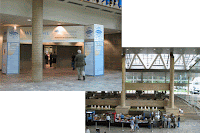 This is Whitman’s second time running this show and their mark was seen riding down the escalator when I noticed that the food court was moved. Rather than being outside the door, the service area was moved to the front lobby at the foot of the escalator. The tables were moved out closer to the lobby and Whitman placed convention-style booths for registration. Also, the entrance had a new canopy announcing the show. It looked more professional than in the past.
This is Whitman’s second time running this show and their mark was seen riding down the escalator when I noticed that the food court was moved. Rather than being outside the door, the service area was moved to the front lobby at the foot of the escalator. The tables were moved out closer to the lobby and Whitman placed convention-style booths for registration. Also, the entrance had a new canopy announcing the show. It looked more professional than in the past.
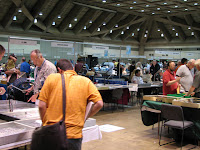 It is still an awe inspiring experience to walk into the hall and see wall-to-wall dealer tables. Adding to the depth of vision was the framing that Whitman used during the last show behind the tables to allow dealers to hang banners. As I began to walk to the left side of Hall A, I noticed that Whitman placed stickers on the floor to mark the row numbers. Looking up, on the columns, they also placed numbered signs showing row numbers and the table number group. The best way I can describe this is that the numbers resemble address numbers on street signs. It is a small touch, but when looking for a specific dealer it really helps.
It is still an awe inspiring experience to walk into the hall and see wall-to-wall dealer tables. Adding to the depth of vision was the framing that Whitman used during the last show behind the tables to allow dealers to hang banners. As I began to walk to the left side of Hall A, I noticed that Whitman placed stickers on the floor to mark the row numbers. Looking up, on the columns, they also placed numbered signs showing row numbers and the table number group. The best way I can describe this is that the numbers resemble address numbers on street signs. It is a small touch, but when looking for a specific dealer it really helps.

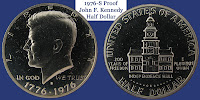 I saw a number of dealers I have bought from and spoken with in the past. Of note I was able to speak with Wayne Herndon, author of the last-page article in July’s Numismatist. The article is really good dry, tongue-in-cheek humor that I found fit Wayne’s personality when you talk with him. Wayne is a good guy and a very fair dealer. From Wayne, I was able to find some 1976 coins that I want to submit to NGC for the registry set. Finding really nice Eisenhower Dollars is very difficult, but Wayne had this 1976-D Type 1 Dollar that I could not pass up. Amongst the other coins I bought was a 1976-S Proof JFK Half Dollar is beautiful.
I saw a number of dealers I have bought from and spoken with in the past. Of note I was able to speak with Wayne Herndon, author of the last-page article in July’s Numismatist. The article is really good dry, tongue-in-cheek humor that I found fit Wayne’s personality when you talk with him. Wayne is a good guy and a very fair dealer. From Wayne, I was able to find some 1976 coins that I want to submit to NGC for the registry set. Finding really nice Eisenhower Dollars is very difficult, but Wayne had this 1976-D Type 1 Dollar that I could not pass up. Amongst the other coins I bought was a 1976-S Proof JFK Half Dollar is beautiful.
Watch out NGC, these coins (and other coins) will be sent this week!
One thing I noticed was that there was a lot of table sharing. While this is a common practice with small dealers, there were some higher volume dealers sharing tables, especially on the corners. For the buyer, this meant that there were more options. I was able to pickup some nice items while junk box diving for resale that I will be posting on eBay soon. Yes, there were some nice items in many of the junk boxes which was surprising.
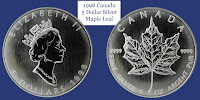 I also had taken the opportunity to try to complete my set of Silver Maple Leaf coins. I was able to find a 1989, 1992, 1996, and 1998. All I am missing from the set is 1990 and 2007. I forgot about the 2007 and did not buy one at the show. All are beautiful coins, but the 1998 is the best. Images of these coins are difficult, but I tried so I can show off their beauty.
I also had taken the opportunity to try to complete my set of Silver Maple Leaf coins. I was able to find a 1989, 1992, 1996, and 1998. All I am missing from the set is 1990 and 2007. I forgot about the 2007 and did not buy one at the show. All are beautiful coins, but the 1998 is the best. Images of these coins are difficult, but I tried so I can show off their beauty.
 As I complete many of my United States sets, I am looking for other areas to explore. One area of interest is the currency of Israel. Coins are interesting, but the Israeli paper is beautiful with nice historical images. But first, I wanted the 2005 Theory of Relativity Commemorative Proof. I purchased a beautiful proof coin from noted dealer in Israeli Numismatics, J.J. van Grover. Van Grover is also the Vice President of the American Israel Numismatic Association, an organization which I recently joined, and we had a chance to talk about AINA and other Israeli issues. But the coin is beautiful whose image cannot do it justice.
As I complete many of my United States sets, I am looking for other areas to explore. One area of interest is the currency of Israel. Coins are interesting, but the Israeli paper is beautiful with nice historical images. But first, I wanted the 2005 Theory of Relativity Commemorative Proof. I purchased a beautiful proof coin from noted dealer in Israeli Numismatics, J.J. van Grover. Van Grover is also the Vice President of the American Israel Numismatic Association, an organization which I recently joined, and we had a chance to talk about AINA and other Israeli issues. But the coin is beautiful whose image cannot do it justice.
I did buy some Israeli paper money. These two notes are from the Fourth Series Pounds dated 1973 but issued in 1975. These notes were demonetized in 1983.
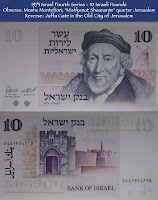

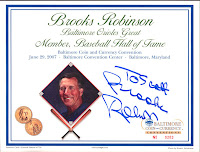 Before going through the rest of the show floor, it was time to take a pause to do something non-numismatic. Appearing at the show was Baltimore Orioles Great and Member of the Baseball Hall of Fame, Brooks Robinson. Robinson is a very gracious gentleman whose current wrist injury he blames on old age. At 70, he may not be able to defend the hot corner but he is not ready for the home either. I did stand on line for his autograph and have my picture taken. Even though my Mets beat his Orioles in 1969, I cannot deny that he was a great player and a classy person. It was a joy to meet him.
Before going through the rest of the show floor, it was time to take a pause to do something non-numismatic. Appearing at the show was Baltimore Orioles Great and Member of the Baseball Hall of Fame, Brooks Robinson. Robinson is a very gracious gentleman whose current wrist injury he blames on old age. At 70, he may not be able to defend the hot corner but he is not ready for the home either. I did stand on line for his autograph and have my picture taken. Even though my Mets beat his Orioles in 1969, I cannot deny that he was a great player and a classy person. It was a joy to meet him.
 Before returning to the bourse floor, I stopped at the nearby Whitman booth. During registration, we were given a coupon for a free copy to The Expert’s Guide to Collecting & Investing in Rare Coins, the latest tome from Q. David Bowers, with a $25 purchase. I almost walked away from the booth before noticing Whitman was selling something that was not numismatic or philatelic related. Whitman now creates something called Football Vault Books. With the publisher from the south, it is not surprising that the series started to cover the Southeastern Conference. When I found the University of Georgia Vault Book I decided to use my coupon after buying the book. The Vault Book is fantastic! It has the history and reproduction of memorabilia from the era being discussed. Ok… back to the coins.
Before returning to the bourse floor, I stopped at the nearby Whitman booth. During registration, we were given a coupon for a free copy to The Expert’s Guide to Collecting & Investing in Rare Coins, the latest tome from Q. David Bowers, with a $25 purchase. I almost walked away from the booth before noticing Whitman was selling something that was not numismatic or philatelic related. Whitman now creates something called Football Vault Books. With the publisher from the south, it is not surprising that the series started to cover the Southeastern Conference. When I found the University of Georgia Vault Book I decided to use my coupon after buying the book. The Vault Book is fantastic! It has the history and reproduction of memorabilia from the era being discussed. Ok… back to the coins.
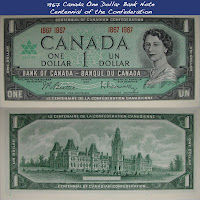 This time, the foreign section was smaller than usual. I was looking for some Canadian coins but was a little disappointed at the selection and the lack of dealers with good Canadian inventory. Rather than walk away empty handed, I bought a 1967 Centennial of the Confederation One Dollar note. It is a crisp, uncirculated note that has a look very reminiscent of the formal aspects of the 1960’s.
This time, the foreign section was smaller than usual. I was looking for some Canadian coins but was a little disappointed at the selection and the lack of dealers with good Canadian inventory. Rather than walk away empty handed, I bought a 1967 Centennial of the Confederation One Dollar note. It is a crisp, uncirculated note that has a look very reminiscent of the formal aspects of the 1960’s.
 As the day was winding down, I needed to buy something old. Somebody had to have something not that expensive but old and fun. I happened upon the table for The Butternut Company out of Clifton, Virginia. Butternut has a nice business of Civil War memorabilia along with the coins. But the had a junk box of well worn large and half cents. Ah ha! Something old! So I searched the small box looking for something with a readable date. In the box I found an 1803 Large Cent that satisfied my old and fun criteria. It is 204 years old and is just loaded with history.
As the day was winding down, I needed to buy something old. Somebody had to have something not that expensive but old and fun. I happened upon the table for The Butternut Company out of Clifton, Virginia. Butternut has a nice business of Civil War memorabilia along with the coins. But the had a junk box of well worn large and half cents. Ah ha! Something old! So I searched the small box looking for something with a readable date. In the box I found an 1803 Large Cent that satisfied my old and fun criteria. It is 204 years old and is just loaded with history.
As I left with ten minutes to closing, dealers were already closing down and vacating. I walked through the Sheraton, purchased a beverage and candy bar from the hotel shop, and retrieved my car from their lot. I left driving around traffic on their way to an Orioles game and found my way to I-395 to head back to the Washington, DC area. During the trip I called my wife to discuss dinner plans and made good time going south on I-95 to the Capital Beltway. I picked up something for dinner and headed home. After being happily greeted by Boomer, I cleaned up and served dinner while telling my wife about the fun I had. Show-and-tell occurred before desert.
In all, it was a wonderful day and a wonderful show.
Click on any image to enlarge. Vault Book cover from Whitman Publishing.
The first is a 2009 Canadian one-dollar coin. Instead of a Loony—the reverse with an image of a common loon—the reverse features a commemorative to the one hundred anniversary of the Montreal Canadiens hockey team. The standard Loonie is an eleven-sided smooth edged coin that is 26.5mm in diameter and made from bronze plated nickel. The 2009 Loonies with the Canadiens Centennial reverse was only circulated in Quebec making it a unique collectible.
The other coin is a 2008 Canadian two-dollar coin commonly called the Toonie. The Toonie is a 28mm bimetallic coin with an outer ring made from nickel and a brass inner core. Normally, the reverse of the Toonie is a polar bear during the early summer ice flow. This Toonie commemorates the 400th Anniversary of the founding of Quebec City and the first French settlement in North America.













